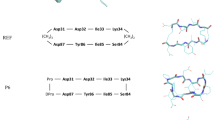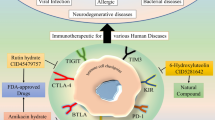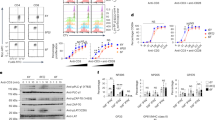Abstract
The immune system has very intricate mechanisms of fighting against the invading infections which are accomplished by a sequential event of molecular interactions in the body. One of the crucial phenomena in this process is the recognition of T-cells by the antigen-presenting cells (APCs), which is initiated by the rapid interaction between both cell surface receptors, i.e., CD2 located on T-cells and CD58 located on APCs. Under various pathological conditions, which involve undesired immune response, inhibiting the CD2–CD58 interactions becomes a therapeutically relevant opportunity. Herein we present an extensive work to identify novel inhibiting agents of the CD2–CD58 interactions. Classical molecular dynamics (MD) simulations of the CD2–CD58 complex highlighted a series of crucial CD58 residues responsible for the interactions with CD2. Based on such results, a pharmacophore map, complementary to the CD2-binding site of CD58, was created and employed for virtual screening of ~ 300,000 available compounds. On the ~ 6000 compounds filtered from pharmacophore mapping, ADME screening leads to ~ 350 molecules. Molecular docking was then performed on these molecules, and fifteen compounds emerged with significant binding energy (< − 50 kcal/mol) for CD58. Finally, short MD simulations were performed in triplicate on each complex (i) to provide a microscopic view of the ligand binding and (ii) to rule out possibly weak binders of CD58 from the identified hits. At last, we suggest eight compounds for in vitro testing that were identified as promising hits to bind CD58 with a high binding affinity.








Similar content being viewed by others
Abbreviations
- ∆Gbind :
-
Binding energy
- Å:
-
Angstrom
- APCs:
-
Antigen-presenting cells
- CD2:
-
Cluster of differentiation 2
- DruLiTo:
-
Drug Likeness Tool
- H-bonds:
-
Hydrogen bonds
- IFD:
-
Induced fit docking
- MD:
-
Molecular dynamics
- MM/GBSA:
-
Molecular mechanics-generalized born surface area
- PME:
-
Particle mesh Ewald
- PDB:
-
RCSB/Protein Data Bank
- QED:
-
Quantitative estimation of druglikeness
- RMSD:
-
Root mean square deviation
- SP:
-
Standard precision
- uwQED:
-
Unweighted quantitative estimation of druglikeness
- VMD:
-
Visual molecular dynamics
- wQED:
-
Weighted quantitative estimation of druglikeness
- XP:
-
eXtra precision
References
Medzhitov R, Janeway CA Jr (1997) Innate immunity: impact on the adaptive immune response. Curr Opin Immunol 9:4–9
Huang J, Meyer C, Zhu C (2012) T cell antigen recognition at the cell membrane. Mol Immunol 52:155–164
Springer TA (1990) Adhesion receptors of the immune system. Nature 346:425–434
Montoya MC, Sancho D, Vicente-Manzanares M, Sánchez-Madrid F (2002) Cell adhesion and polarity during immune interactions. Immunol Rev 186:68–82
Wang P, Qi BT, Chen P, He LJ, Li J, Ji YQ, Xie M (2008) CD58 expression of liver tissue in patients with chronic hepatitis B virus infection. Chin Med J 121:557–560
Sheng L, Li J, Qi BT, Ji YQ, Meng ZJ, Xie M (2006) Investigation on correlation between expression of CD58 molecule and severity of hepatitis B. World J Gastroenterol 12:4237–4240
Shao T, Shi W, Zheng JY, Xu XX, Lin AF, Xiang LX, Shao JZ (2018) Costimulatory function of Cd58/Cd2 interaction in adaptive humoral immunity in a zebrafish model. Front Immunol 9:1204
Mojcik CF, Shevach EM (1997) Adhesion molecules: a rheumatologic perspective. Arthritis Rheum 40:991–1004
Raychaudhuri S, Thomson BP, Remmers EF, Eyre S, Hinks A, Guiducci C, Catanese JJ, Xie G, Stahl EA, Chen R, Alfredsson L, Amos CI, Ardlie KG, Barton A, Bowes J, Burtt NP, Chang M, Coblyn J, Costenbader KH, Criswell LA, Crusius JBA, Cui J, de Jager PL, Ding B, Emery P, Flynn E, Harrison P, Hocking LJ, Huizinga TWJ, Kastner DL, Ke X, Kurreeman FAS, Lee AT, Liu X, Li Y, Martin P, Morgan AW, Padyukov L, Reid DM, Seielstad M, Seldin MF, Shadick NA, Steer S, Tak PP, Thomson W, van der Helm-Van Mil AHM, van der Horst-Bruinsma IE, Weinblatt ME, Wilson AG, Wolbink GJ, Wordsworth P, Altshuler D, Karlson EW, Toes REM, de Vries N, Begovich AB, Siminovitch KA, Worthington J, Klareskog L, Gregersen PK, Daly MJ, Plenge RM (2009) Genetic variants at CD28, PRDM1 and CD2/CD58 are associated with rheumatoid arthritis risk. Nat Genet 41:1313–1320
Lerut J, Van Thuyne V, Mathijs J, Lemaire J, Talpe S, Roggen F, Ciccarelli O, Zuckermann M, Goffette P, Hope J, Gianello P, Bazin H, Cornet A, Rahier J, Latinne D (2005) Anti-CD2 monoclonal antibody and tacrolimus in adult liver transplantation. Transplantation 80:1186–1193
Lee E, Lee SJ, Koskimaki JE, Han Z, Pandey NB, Popel AS (2014) Inhibition of breast cancer growth and metastasis by a biomimetic peptide. Sci Rep 4:7139
Gollob JA, Li J, Kawasaki H, Daley JF, Groves C, Reinherz EL, Ritz J (1996) Molecular interaction between CD58 and CD2 counter-receptors mediates the ability of monocytes to augment T cell activation by IL-12. J Immunol 157:1886–1893
Aruffo A, Hollenbaugh D (2001) Therapeutic intervention with inhibitors of co-stimulatory pathways in autoimmune disease. Curr Opin Immunol 13:683–686
Przepiorka D, Phillips GL, Ratanatharathorn V, Cottler-Fox M, Sehn LH, Antin JH, LeBherz D, Awwad M, Hope J, McClain JB (1998) A phase II study of BTI-322, a monoclonal anti-CD2 antibody, for treatment of steroid-resistant acute graft-versus-host disease. Blood 92:4066–4071
Branco L, Barren P, Mao SY, Pfarr D, Kaplan R, Postema C, Langermann S, Koenig S, Johnson S (1999) Selective deletion of antigen-specific, activated T cells by a humanized MAB to CD2 (MEDI-507) is mediated by NK cells. Transplantation 68:1588–1596
Liu J, Chow VTK, Jois SDS (2004) A novel, rapid and sensitive heterotypic cell adhesion assay for CD2-CD58 interaction, and its application for testing inhibitory peptides. J Immunol Methods 291:39–49
Wang JH, Smolyar A, Tan K, Liu JH, Kim M, Sun ZYJ, Wagner G, Reinherz EL (1999) Structure of a heterophilic adhesion complex between the human CD2 and CD58 (LFA-3) counterreceptors. Cell 97:791–803
Bayas MV, Schulten K, Leckband D (2003) Forced detachment of the CD2-CD58 complex. Biophys J 84:2223–2233
Wang X, Ji CG, Zhang JZH (2015) Glycosylation modulates human CD2-CD58 adhesion via conformational adjustment. J Phys Chem B 119:6493–6501
Sun ZYJ, Dötsch V, Kim M, Li J, Reinherz EL, Wagner G (1999) Functional glycan-free adhesion domain of human cell surface receptor CD58: design, production and NMR studies. EMBO J 18:2941–2949
Liu J, Ying J, Chow VTK, Hruby VJ, Satyanarayanajois SD (2005) Structure-activity studies of peptides from the ‘hot-spot’ region of human CD2 protein: development of peptides for immunomodulation. J Med Chem 48:6236–6249
Liu J, Li C, Ke S, Satyanarayanajois SD (2007) Structure-based rational design of β-hairpin peptides from discontinuous epitopes of Cluster of Differentiation 2 (CD2) protein to modulate cell adhesion interaction. J Med Chem 50:4038–4047
Giddu S, Subramanian V, Yoon HS, Satyanarayanajois SD (2009) Design of β-hairpin peptides for modulation of cell adhesion by β-turn constraint. J Med Chem 52:726–736
Gokhale A, Weldeghiorghis TK, Taneja V, Satyanarayanajois SD (2011) Conformationally constrained peptides from CD2 to modulate protein-protein interactions between CD2 and CD58. J Med Chem 54:5307–5319
Gokhale AS, Sable R, Walker JD, McLaughlin L, Kousoulas KG, Jois SD (2015) Inhibition of cell adhesion and immune responses in the mouse model of collagen-induced arthritis with a peptidomimetic that blocks CD2-CD58 interface interactions. Biopolymers 104:733–742
Leherte L, Petit A, Jacquemin D, Vercauteren DP, Laurent AD (2018) Investigating cyclic peptides inhibiting CD2–CD58 interactions through molecular dynamics and molecular docking methods. J Comput Aided Mol Des 32:1295–1313
Case DA, Ben-Shalom IY, Brozell SR, Cerutti DS, Cheatham III TE, Cruzeiro VWD, Darden TA, Duke RE, Ghoreishi D, Gilson MK, Gohlke H, Goetz AW, Greene D, Harris R, Homeyer N, Izadi S, Kovalenko A, Kurtzman T, Lee TS, LeGrand S, Li P, Lin C, Liu J, Luchko T, Luo R, Mermelstein DJ, Merz KM, Miao Y, Monard G, Nguyen C, Nguyen H, Omelyan I, Onufriev A, Pan F, Qi R, Roe DR, Roitberg A, Sagui C, Schott-Verdugo S, Shen J, Simmerling CL, Smith J, Salomon-Ferrer R, Swails J, Walker RC, Wang J, Wei H, Wolf RM, Wu X, Xiao L, York DM, Kollman PA (2018), AMBER 2018, University of California, San Francisco.
Bas DC, Rogers DM, Jensen JH (2008) Very fast prediction and rationalization of pKa values for protein-ligand complexes. Proteins Struct Funct Genet 73:765–783
Wang J, Wolf RM, Caldwell JW, Kollman PA, Case DA (2004) Development and testing of a general Amber force field. J Comput Chem 25:1157–1174
Hornak V, Abel R, Okur A, Strockbine B, Roitberg A, Simmerling C (2006) Comparison of multiple amber force fields and development of improved protein backbone parameters. Proteins Struct Funct Genet 65:712–725
Vassetti D, Pagliai M, Procacci P (2019) Assessment of GAFF2 and OPLS-AA general force fields in combination with the water models TIP3P, SPCE, and OPC3 for the solvation free energy of druglike organic molecules. J Chem Theory Comput 15:1983–1995
Maier JA, Martinez C, Kasavajhala K, Wickstrom L, Hauser KE, Simmerling C (2015) ff14SB: improving the accuracy of protein side chain and backbone Parameters from ff99SB. J Chem Theory Comput 11:3696–3713
Roe DR, Cheatham TE III (2013) PTRAJ and CPPTRAJ: software for processing and analysis of molecular dynamics trajectory data. J Chem Theory Comput 9:3084–3095
Humphrey W, Dalke A, Schulten K (1996) VMD: visual molecular dynamics. J Mol Gr. 14:33–38
Genheden S, Ryde U (2015) The MM/PBSA and MM/GBSA methods to estimate ligand-binding affinities. Expert Opin Drug Discov 10:449–461
Arulanandam ARN, Withka JM, Wyss DF, Wagner G, Kister A, Pallai P, Recny MA, Reinherz EL (1993) The CD58 (LFA-3) binding site is a localized and highly charged surface area on the AGFCC’C’’ face of the human CD2 adhesion domain. Proc Natl Acad Sci USA 90:11613–11617
Dixon SL, Smondyrev AM, Knoll EH, Rao SN, Shaw DE, Friesner RA (2006) PHASE: a new engine for pharmacophore perception, 3D QSAR model development, and 3D database screening: 1. Methodology and preliminary results. J Comput Aided Mol Des 20:647–671
Dixon SL, Smondyrev AM, Rao SN (2006) PHASE: a novel approach to pharmacophore modeling and 3D database searching. Chem Biol Drug Des 67:370–372
Phase, Schrödinger LLC NY (2019)
Sastry GM, Adzhigirey M, Day T, Annabhimoju R, Sherman W (2013) Protein and ligand preparation: parameters, protocols, and influence on virtual screening enrichments. J Comput Aided Mol Des 27:221–234
LigPrep, Schrödinger LLC NY (2019)
Shelley JC, Cholleti A, Frye LL, Greenwood JR, Timlin MR, Uchimaya M (2007) Epik: a software program for pKa prediction and protonation state generation for drug-like molecules. J Comput Aided Mol Des 21:681–691
Greenwood JR, Calkins D, Sullivan AP, Shelley JC (2010) Towards the comprehensive, rapid, and accurate prediction of the favorable tautomeric states of drug-like molecules in aqueous solution. J Comput Aided Mol Des 24:591–604
Schrödinger LLC NY (2019)
Watts KS, Dalal P, Murphy RB, Sherman W, Friesner RA, Shelley JC (2010) ConfGen: a conformational search method for efficient generation of bioactive conformers. J Chem Inf Model 50:534–546
ConfGen, Schrödinger, LLC, New York, NY (2019)
DruLiTo. http://www.niper.gov.in/pi_dev_tools/DruLiToWeb/DruLiTo_index.html
Lipinski CA, Lombardo F, Dominy BW, Feeney PJ (1997) Experimental and computational approaches to estimate solubility and permeability in drug discovery and development settings. Adv Drug Deliv Rev 23:3–25
Ghose AK, Viswanadhan VN, Wendoloski JJ (1999) A knowledge-based approach in designing combinatorial or medicinal chemistry libraries for drug discovery. 1. A qualitative and quantitative characterization of known drug databases. J Comb Chem 1:55–68
Veber DF, Johnson SR, Cheng HY, Smith BR, Ward KW, Kopple KD (2002) Molecular properties that influence the oral bioavailability of drug candidates. J Med Chem 45:2615–2623
Oprea TI (2000) Property distribution of drug-related chemical databases. J Comput Aided Mol Des 14:251–264
Norinder U, Haeberlein M (2002) Computational approaches to the prediction of the blood-brain distribution. Adv Drug Deliv Rev 54:291–313
Bickerton GR, Paolini GV, Besnard J, Muresan S, Hopkins AL (2012) Quantifying the chemical beauty of drugs. Nat Chem 4:90–98
QikProp, Schrödinger, LLC, New York, NY (2019)
Protein Preparation Wizard, Schrödinger, LLC, New York, NY (2019)
Dolinsky TJ, Nielsen JE, McCammon JA, Baker NA (2004) PDB2PQR: an automated pipeline for the setup of Poisson-Boltzmann electrostatics calculations. Nucleic Acids Res 32:W665–W667
Friesner RA, Banks JL, Murphy RB, Halgren TA, Klicic JJ, Mainz DT, Repasky MP, Knoll EH, Shelley M, Perry JK, Shaw DE, Francis P, Shenkin PS (2004) Glide: a new approach for rapid, accurate docking and scoring. 1. Method and assessment of docking accuracy. J Med Chem 47:1739–1749
Halgren TA, Murphy RB, Friesner RA, Beard HS, Frye LL, Pollard WT, Banks JL (2004) Glide: a new approach for rapid, accurate docking and scoring. 2. Enrichment factors in database screening. J Med Chem 47:1750–1759
Friesner RA, Murphy RB, Repasky MP, Frye LL, Greenwood JR, Halgren TA, Sanschagrin PC, Mainz DT (2006) Extra precision glide: docking and scoring incorporating a model of hydrophobic enclosure for protein-ligand complexes. J Med Chem 49:6177–6196
Glide, version 5.7, Schrödinger, LLC, New York, NY (2019)
Sherman W, Day T, Jacobson MP, Friesner RA, Farid R (2006) Novel procedure for modeling ligand/receptor induced fit effects. J Med Chem 49:534–553
Sherman W, Beard HS, Farid R (2006) Use of an induced fit receptor structure in virtual screening. Chem Biol Drug Des 67:83–84
Induced Fit Docking Protocol, Schrödinger LLC NY (2019)
Jorgensen WL, Maxwell DS, Tirado-Rives J (1996) Development and testing of the OPLS all-atom force field on conformational energetics and properties of organic liquids. J Am Chem Soc 118:11225–11236
Acknowledgements
NT thanks the Région Pays de la Loire and the Centre National de la Recherche Scientifique (CNRS) for the financial support during her post-doctoral research within the PIRAMID and MimBreg projects. ADL acknowledges the Région Pays de la Loire for financial support within the framework of PIRAMID and MiM-Breg project. This research used computational resources of CCIPL (Centre de Calcul Intensif des Pays de Loire). Funding was provided by the Wallonie-Bruxelles International WBI (PHC Tournesol DoIFAD) and the Belgian National Foundation for Scientific Research (FNRS), by the French Ministry of Foreign and European Affairs, and by the Ministry of Higher Education and Research, in the framework of the Hubert Curien partnerships (PHC Tournesol #40638PL).
Author information
Authors and Affiliations
Corresponding authors
Ethics declarations
Conflicts of interest
The authors declare no conflict of interest.
Additional information
Publisher's Note
Springer Nature remains neutral with regard to jurisdictional claims in published maps and institutional affiliations.
Supplementary information
Below is the link to the electronic supplementary material.
Rights and permissions
About this article
Cite this article
Tripathi, N., Leherte, L., Vercauteren, D.P. et al. Structure-based identification of inhibitors disrupting the CD2–CD58 interactions. J Comput Aided Mol Des 35, 337–353 (2021). https://doi.org/10.1007/s10822-020-00369-z
Received:
Accepted:
Published:
Issue Date:
DOI: https://doi.org/10.1007/s10822-020-00369-z




